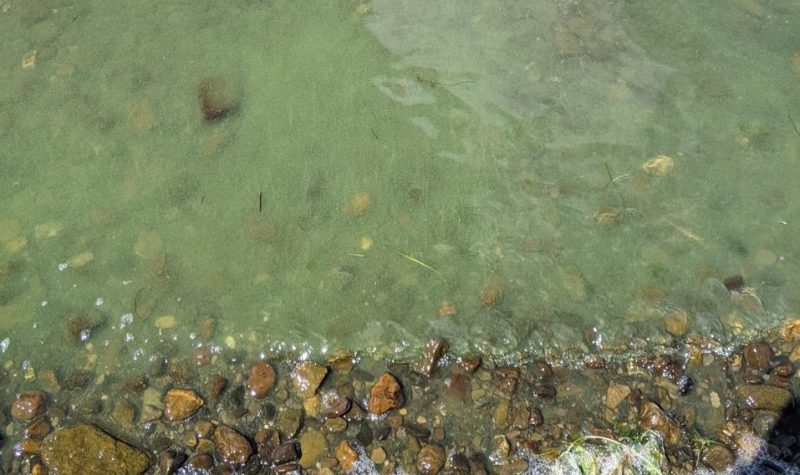Blue-green algae blooms made an early appearance in Brome Lake on July 7, resulting in the closure of Douglass Beach for the day.
Anaïs Renaud, biologist for Renaissance Lac-Brome (RLB), said that its presence in Brome Lake came after a stormy couple of days in the area, resulting in rainwater runoff increasing the level of phosphorus in the lake. Depending on the forecast for this summer, it may not be the last that Brome Lake sees of the cyanobacteria.
“They (blue-green algae) are natural elements in an aquatic ecosystem, but it’s just when we feed them with phosphorus that they can develop, bloom, and turn into scum,” explained Renaud. “The problem with cyanobacteria (…) is that they can produce toxins and other compounds that are harmful humans and animals. That’s why it’s a problem when they develop in lakes.”
Renaud continued to explain that an increase in phosphorus, which is also a natural element, comes from fertilizer, soils, and boats circulating in shallow waters that measure less than five meters.
“If we wanted green grass, for example, we put fertilizer and the phosphorus in fertilizers can run off in waters. The problem is that, in Brome Lake for example, there is a history of agriculture and citizens around the lake that do not have the same education that we have now,” she said. “So, at the time, they didn’t know that they needed vegetated banks, they didn’t know that we should not apply fertilizer directly on the banks, and now the soils are saturated.”
Addressing the scenario of blue-green algae that Brome Lake experienced about a week and a half ago, Renaud noted that the cyanobacteria is making an earlier appearance than usual, often peaking around August or September.
“This year, what we are experiencing is heavy rains. A few days after the heavy rains, we can see the cyanobacteria coming out. It’s because the heavy rains increase runoff so water does not have enough time to filter through the soil. It brings sediments, dirt, nutrients and other contaminants to streams,” said Renaud.
If the heavy rains trail off throughout the summer, Renaud said that it is likely that Brome Lake will see less algae blooms, but that the situation all depends on the meteorological conditions.
“If it’s raining or if it’s very dry, if it becomes really hot, in the fall, we can see them developing later than usual,” she noted.
Every time RLB is made aware of the presence of blue-green algae in the lake, it monitors the issue.
“We go on the lake, we measure the surface of the cyanobacteria, what kind of cyanobacteria it is, and we did a report to the Ministry of Environment. Anyone can make that report. If they see blue-green algae scum, they can contact us or directly make a report on the website of the Ministry of Environment’s,” mentioned Renaud.
The non-profit organization, whose mission is to protect Brome Lake and its watershed, also sensitizes people as to how they can play their part.
“It’s not just people around the lake that need to be careful, it’s everyone in the watershed. People that live on the lake, what you can do is make sure that you have you bank vegetated at 15 meters, do not cut the grass, (…), do not apply any fertilizer or pesticides, make sure you have no runoff going into the lake, make sure you septic installations are tight and not leaking, that’s very very important. We have measurements that tell us that there are medications, soaps, and cosmetics in the lake,” explained Renaud.
To make a report on a sighting of blue-green algae in Brome Lake, contact Renaissance Lac-Brome or/and Quebec’s Ministry of Environment.
Listen to the full interview below:


